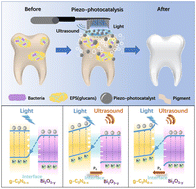Bifunctional defect mediated direct Z-scheme g-C3N4−x/Bi2O3−y heterostructures with enhanced piezo-photocatalytic properties for efficient tooth whitening and biofilm eradication†
Abstract
Biofilm-associated dental diseases and tooth discoloration have recently become the major barriers to achieve healthy teeth. However, there are few effective strategies to address these issues. Herein, the piezo-photocatalytic process is first proposed to be applied for biofilm eradication and tooth whitening with well-designed direct Z scheme g-C3N4−x/Bi2O3−y heterostructures. DFT calculation and XPS results verify the formation of direct Z scheme g-C3N4/Bi2O3 heterostructures theoretically and experimentally. Using the direct Z scheme g-C3N4−x/Bi2O3−y heterostructure, excellent piezo-photocatalytic effects for tooth whitening and biofilm removal are achieved. For piezo-photocatalytic degradation of the typical food colorant of indigo carmine the degradation rate constant is about quadruple that of piezocatalytic and 2.6 times of photocatalytic treatment. Tooth whitening experiments indicate that g-C3N4−x/Bi2O3−y could whiten the stained teeth through the synergistic piezo-photocatalysis. In addition, excellent antibacterial performances can be obtained on the g-C3N4−x/Bi2O3−y heterostructure through piezo-photocatalytic treatment. Not only the planktonic S. mutans but also those bacteria embedded in biofilms can be effectively killed. The analyses of the piezo-photocatalytic mechanism indicates that the enhanced piezo-photocatalytic performance of the g-C3N4−x/Bi2O3−y heterostructure could be attributed to the much higher separation efficiency of photoexcited charge carriers, increased production amounts of ROS and superior adsorption ability for bacteria than those with bare semiconductors of g-C3N4−x and Bi2O3−y and those treated only with ultrasonic vibration or irradiation. Biosafety results show that the g-C3N4−x/Bi2O3−y heterostructure is biologically safe and piezo-photocatalytic treatment has no harm the tooth structure, demonstrating the great potential of piezo-photocatalytic effect based new tooth whitening and antibacterial technology in future dental care fields.

- This article is part of the themed collections: 2023 Journal of Materials Chemistry B HOT Papers and #MyFirstJMCB


 Please wait while we load your content...
Please wait while we load your content...